Examining Leadership's Impact on Tesco Plc's Market Competitiveness
VerifiedAdded on 2020/06/06
|17
|5011
|217
Report
AI Summary
This report provides a comprehensive analysis of the impact of leadership on the organizational competitiveness of Tesco Plc, a leading British supermarket. The study investigates the concept of leadership and competitive advantage, exploring various leadership styles and skills essential for effective team management. It examines the influence of leadership on Tesco Plc's market success, including strategies for workforce management and achieving a competitive edge. The research employs a mixed-methods approach, utilizing primary data from surveys and secondary data from web research and scholarly articles, to evaluate leadership's role in strengthening Tesco's market position. The report covers the historical context, problem statement, research aims, objectives, questions, and deliverables, along with an extensive literature review on leadership styles, competitive benefits, and their impact on business performance. Furthermore, the methodology section outlines the research paradigm, data collection methods, sampling techniques, and ethical considerations. The report concludes with resource implications and a detailed timeline for the research project.
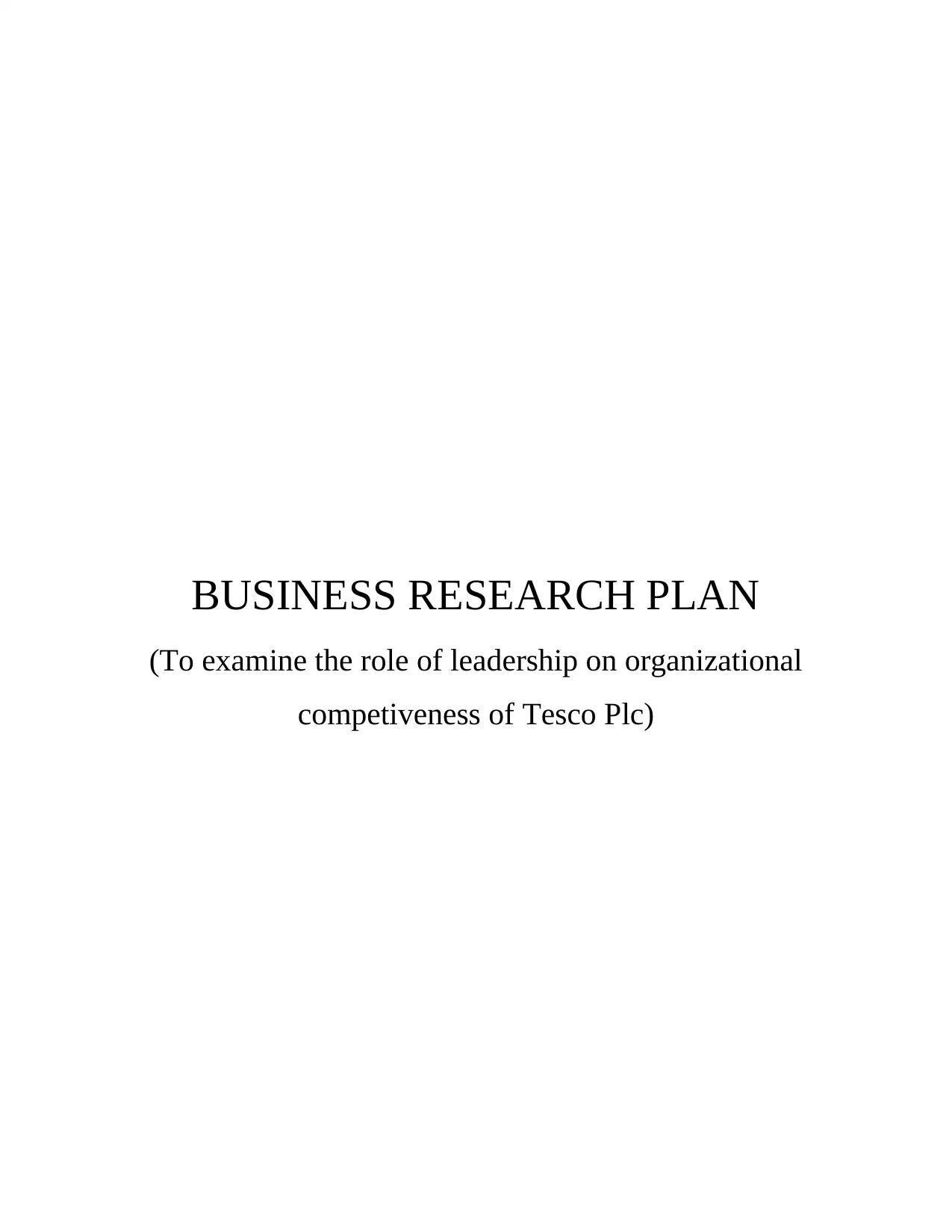
BUSINESS RESEARCH PLAN
(To examine the role of leadership on organizational
competiveness of Tesco Plc)
(To examine the role of leadership on organizational
competiveness of Tesco Plc)
Paraphrase This Document
Need a fresh take? Get an instant paraphrase of this document with our AI Paraphraser
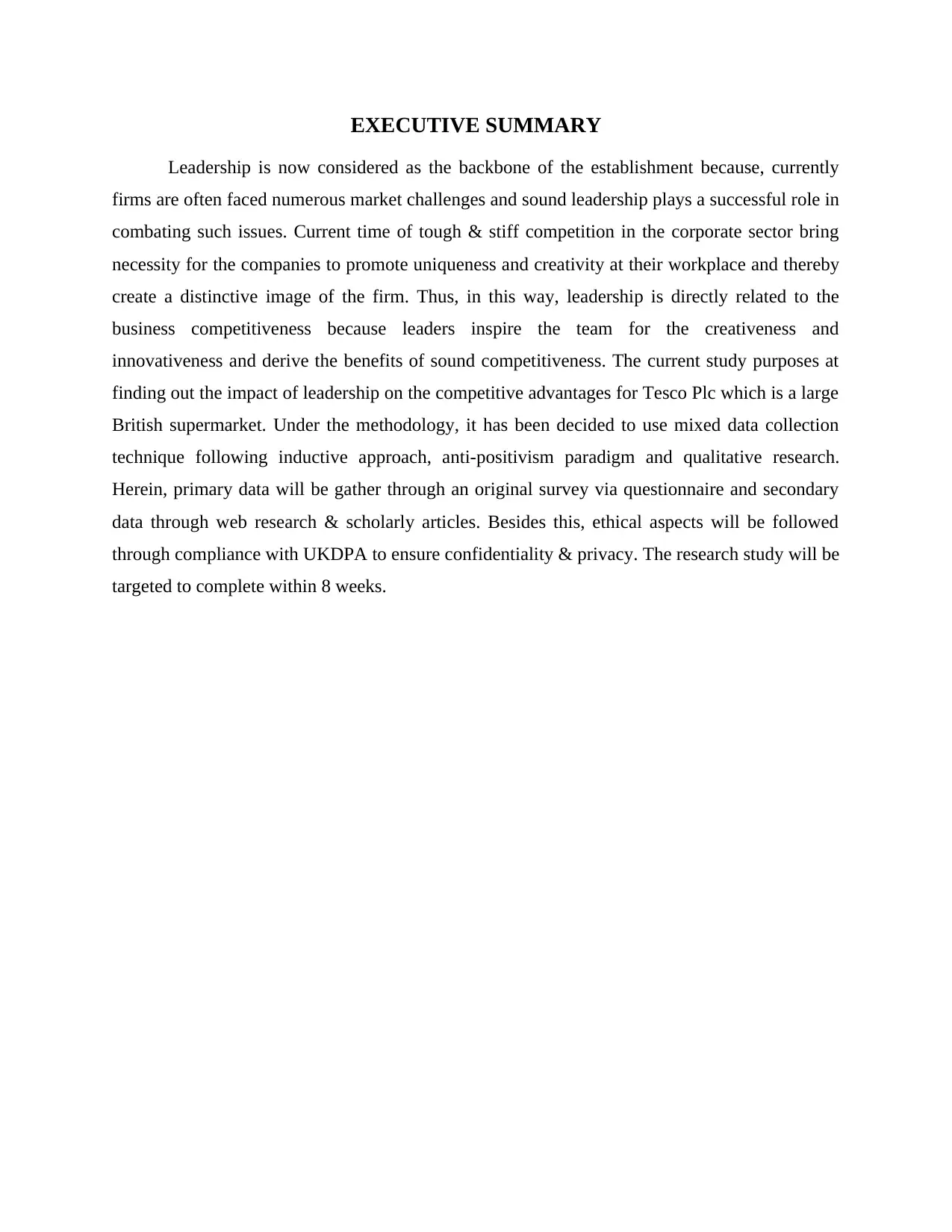
EXECUTIVE SUMMARY
Leadership is now considered as the backbone of the establishment because, currently
firms are often faced numerous market challenges and sound leadership plays a successful role in
combating such issues. Current time of tough & stiff competition in the corporate sector bring
necessity for the companies to promote uniqueness and creativity at their workplace and thereby
create a distinctive image of the firm. Thus, in this way, leadership is directly related to the
business competitiveness because leaders inspire the team for the creativeness and
innovativeness and derive the benefits of sound competitiveness. The current study purposes at
finding out the impact of leadership on the competitive advantages for Tesco Plc which is a large
British supermarket. Under the methodology, it has been decided to use mixed data collection
technique following inductive approach, anti-positivism paradigm and qualitative research.
Herein, primary data will be gather through an original survey via questionnaire and secondary
data through web research & scholarly articles. Besides this, ethical aspects will be followed
through compliance with UKDPA to ensure confidentiality & privacy. The research study will be
targeted to complete within 8 weeks.
Leadership is now considered as the backbone of the establishment because, currently
firms are often faced numerous market challenges and sound leadership plays a successful role in
combating such issues. Current time of tough & stiff competition in the corporate sector bring
necessity for the companies to promote uniqueness and creativity at their workplace and thereby
create a distinctive image of the firm. Thus, in this way, leadership is directly related to the
business competitiveness because leaders inspire the team for the creativeness and
innovativeness and derive the benefits of sound competitiveness. The current study purposes at
finding out the impact of leadership on the competitive advantages for Tesco Plc which is a large
British supermarket. Under the methodology, it has been decided to use mixed data collection
technique following inductive approach, anti-positivism paradigm and qualitative research.
Herein, primary data will be gather through an original survey via questionnaire and secondary
data through web research & scholarly articles. Besides this, ethical aspects will be followed
through compliance with UKDPA to ensure confidentiality & privacy. The research study will be
targeted to complete within 8 weeks.
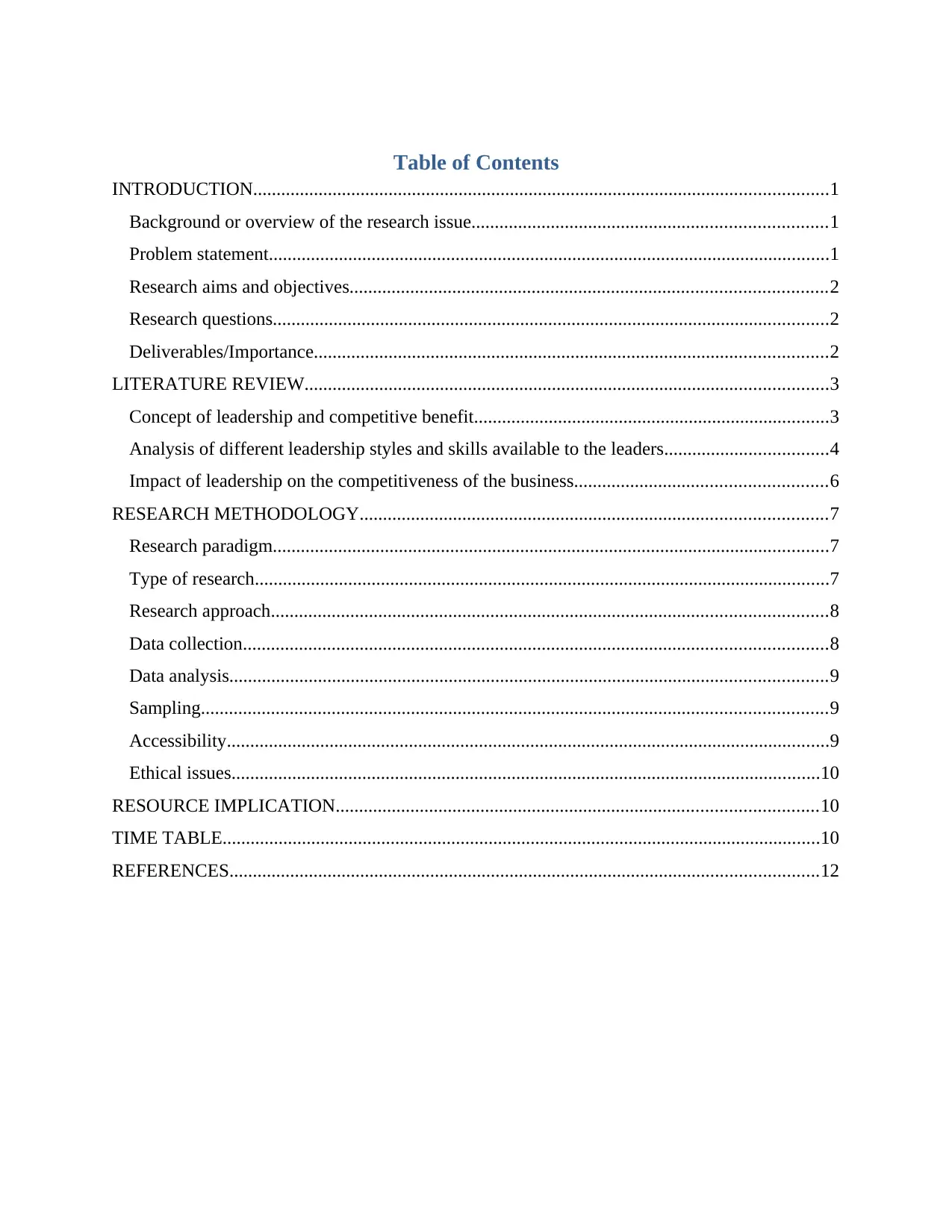
Table of Contents
INTRODUCTION...........................................................................................................................1
Background or overview of the research issue............................................................................1
Problem statement........................................................................................................................1
Research aims and objectives......................................................................................................2
Research questions.......................................................................................................................2
Deliverables/Importance..............................................................................................................2
LITERATURE REVIEW................................................................................................................3
Concept of leadership and competitive benefit............................................................................3
Analysis of different leadership styles and skills available to the leaders...................................4
Impact of leadership on the competitiveness of the business......................................................6
RESEARCH METHODOLOGY....................................................................................................7
Research paradigm.......................................................................................................................7
Type of research...........................................................................................................................7
Research approach.......................................................................................................................8
Data collection.............................................................................................................................8
Data analysis................................................................................................................................9
Sampling......................................................................................................................................9
Accessibility.................................................................................................................................9
Ethical issues..............................................................................................................................10
RESOURCE IMPLICATION.......................................................................................................10
TIME TABLE................................................................................................................................10
REFERENCES..............................................................................................................................12
INTRODUCTION...........................................................................................................................1
Background or overview of the research issue............................................................................1
Problem statement........................................................................................................................1
Research aims and objectives......................................................................................................2
Research questions.......................................................................................................................2
Deliverables/Importance..............................................................................................................2
LITERATURE REVIEW................................................................................................................3
Concept of leadership and competitive benefit............................................................................3
Analysis of different leadership styles and skills available to the leaders...................................4
Impact of leadership on the competitiveness of the business......................................................6
RESEARCH METHODOLOGY....................................................................................................7
Research paradigm.......................................................................................................................7
Type of research...........................................................................................................................7
Research approach.......................................................................................................................8
Data collection.............................................................................................................................8
Data analysis................................................................................................................................9
Sampling......................................................................................................................................9
Accessibility.................................................................................................................................9
Ethical issues..............................................................................................................................10
RESOURCE IMPLICATION.......................................................................................................10
TIME TABLE................................................................................................................................10
REFERENCES..............................................................................................................................12
⊘ This is a preview!⊘
Do you want full access?
Subscribe today to unlock all pages.

Trusted by 1+ million students worldwide
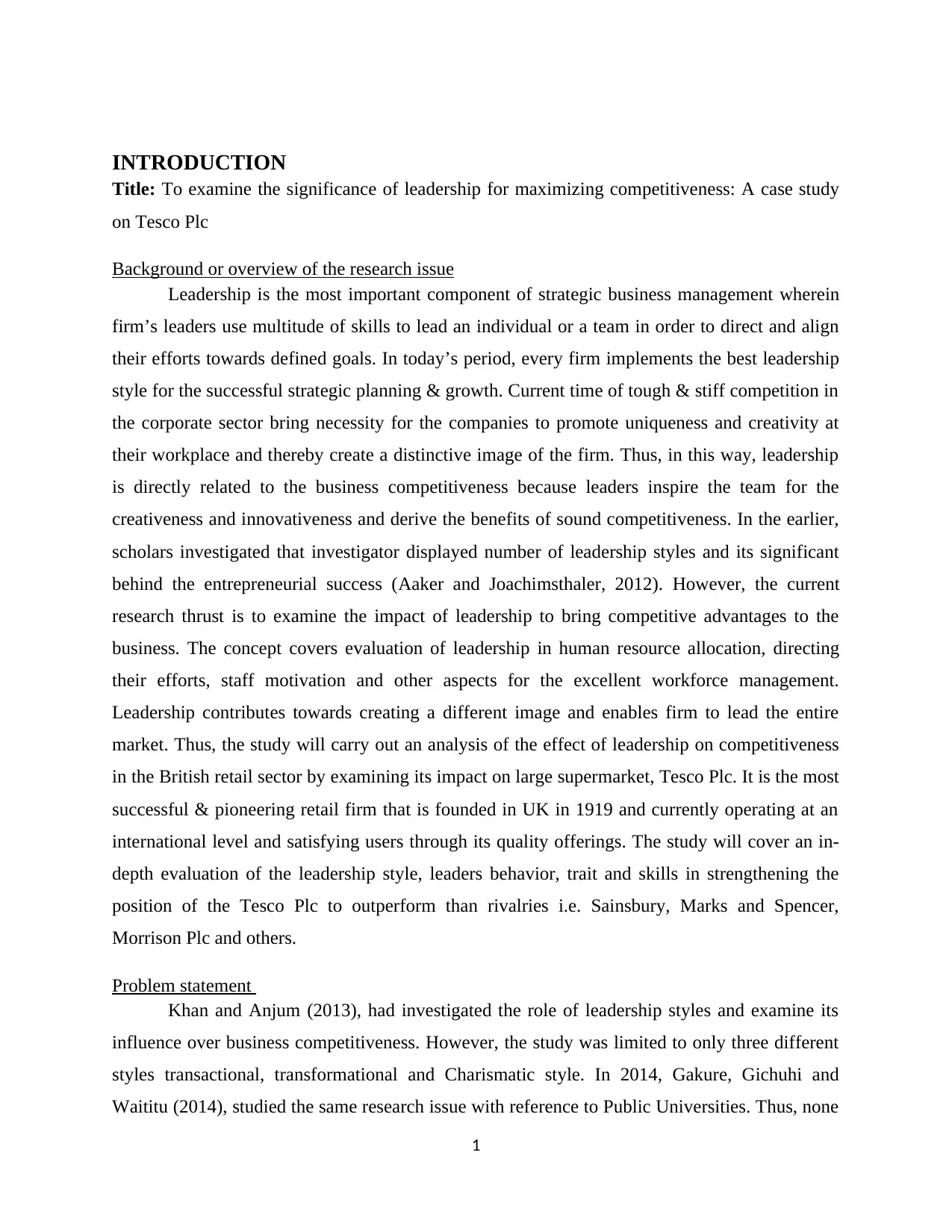
INTRODUCTION
Title: To examine the significance of leadership for maximizing competitiveness: A case study
on Tesco Plc
Background or overview of the research issue
Leadership is the most important component of strategic business management wherein
firm’s leaders use multitude of skills to lead an individual or a team in order to direct and align
their efforts towards defined goals. In today’s period, every firm implements the best leadership
style for the successful strategic planning & growth. Current time of tough & stiff competition in
the corporate sector bring necessity for the companies to promote uniqueness and creativity at
their workplace and thereby create a distinctive image of the firm. Thus, in this way, leadership
is directly related to the business competitiveness because leaders inspire the team for the
creativeness and innovativeness and derive the benefits of sound competitiveness. In the earlier,
scholars investigated that investigator displayed number of leadership styles and its significant
behind the entrepreneurial success (Aaker and Joachimsthaler, 2012). However, the current
research thrust is to examine the impact of leadership to bring competitive advantages to the
business. The concept covers evaluation of leadership in human resource allocation, directing
their efforts, staff motivation and other aspects for the excellent workforce management.
Leadership contributes towards creating a different image and enables firm to lead the entire
market. Thus, the study will carry out an analysis of the effect of leadership on competitiveness
in the British retail sector by examining its impact on large supermarket, Tesco Plc. It is the most
successful & pioneering retail firm that is founded in UK in 1919 and currently operating at an
international level and satisfying users through its quality offerings. The study will cover an in-
depth evaluation of the leadership style, leaders behavior, trait and skills in strengthening the
position of the Tesco Plc to outperform than rivalries i.e. Sainsbury, Marks and Spencer,
Morrison Plc and others.
Problem statement
Khan and Anjum (2013), had investigated the role of leadership styles and examine its
influence over business competitiveness. However, the study was limited to only three different
styles transactional, transformational and Charismatic style. In 2014, Gakure, Gichuhi and
Waititu (2014), studied the same research issue with reference to Public Universities. Thus, none
1
Title: To examine the significance of leadership for maximizing competitiveness: A case study
on Tesco Plc
Background or overview of the research issue
Leadership is the most important component of strategic business management wherein
firm’s leaders use multitude of skills to lead an individual or a team in order to direct and align
their efforts towards defined goals. In today’s period, every firm implements the best leadership
style for the successful strategic planning & growth. Current time of tough & stiff competition in
the corporate sector bring necessity for the companies to promote uniqueness and creativity at
their workplace and thereby create a distinctive image of the firm. Thus, in this way, leadership
is directly related to the business competitiveness because leaders inspire the team for the
creativeness and innovativeness and derive the benefits of sound competitiveness. In the earlier,
scholars investigated that investigator displayed number of leadership styles and its significant
behind the entrepreneurial success (Aaker and Joachimsthaler, 2012). However, the current
research thrust is to examine the impact of leadership to bring competitive advantages to the
business. The concept covers evaluation of leadership in human resource allocation, directing
their efforts, staff motivation and other aspects for the excellent workforce management.
Leadership contributes towards creating a different image and enables firm to lead the entire
market. Thus, the study will carry out an analysis of the effect of leadership on competitiveness
in the British retail sector by examining its impact on large supermarket, Tesco Plc. It is the most
successful & pioneering retail firm that is founded in UK in 1919 and currently operating at an
international level and satisfying users through its quality offerings. The study will cover an in-
depth evaluation of the leadership style, leaders behavior, trait and skills in strengthening the
position of the Tesco Plc to outperform than rivalries i.e. Sainsbury, Marks and Spencer,
Morrison Plc and others.
Problem statement
Khan and Anjum (2013), had investigated the role of leadership styles and examine its
influence over business competitiveness. However, the study was limited to only three different
styles transactional, transformational and Charismatic style. In 2014, Gakure, Gichuhi and
Waititu (2014), studied the same research issue with reference to Public Universities. Thus, none
1
Paraphrase This Document
Need a fresh take? Get an instant paraphrase of this document with our AI Paraphraser
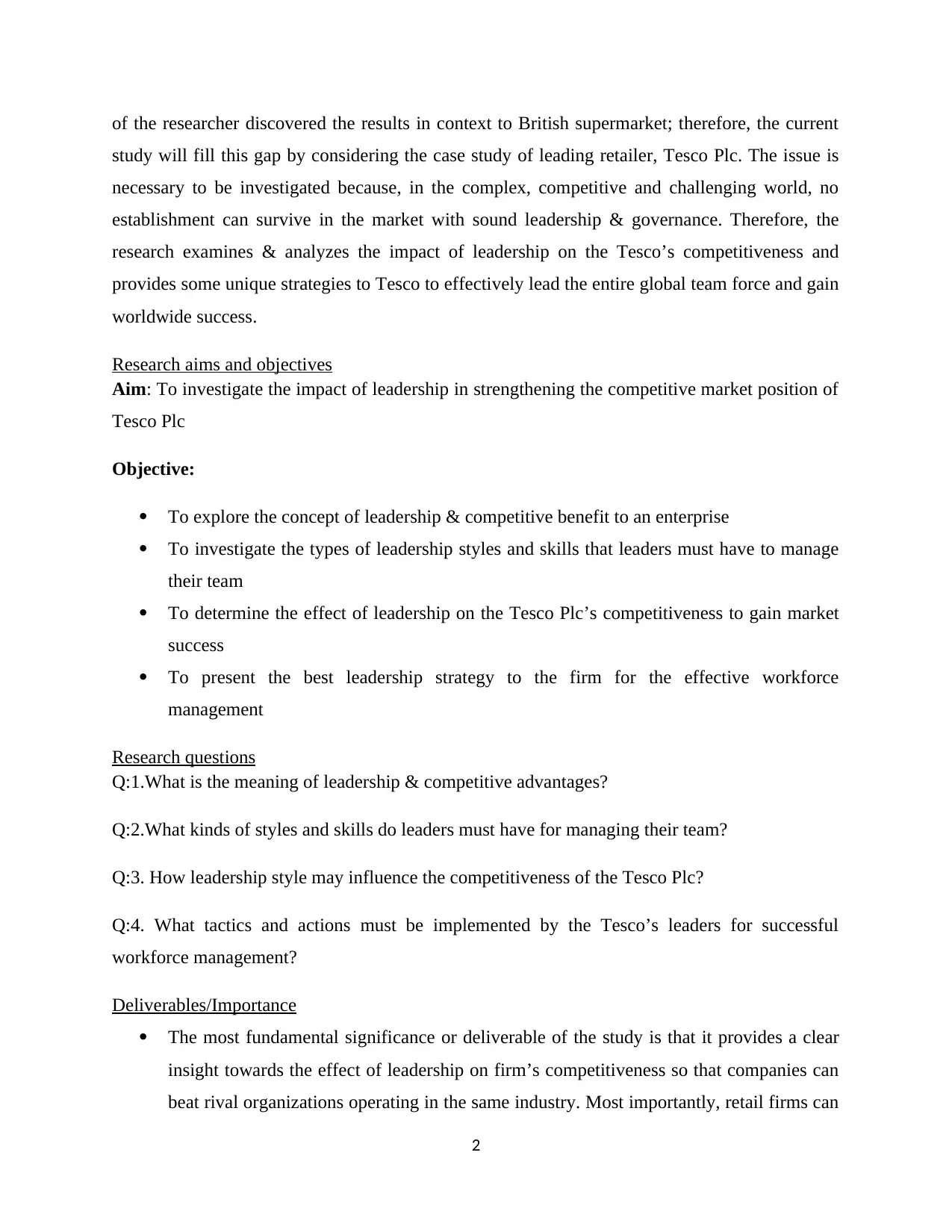
of the researcher discovered the results in context to British supermarket; therefore, the current
study will fill this gap by considering the case study of leading retailer, Tesco Plc. The issue is
necessary to be investigated because, in the complex, competitive and challenging world, no
establishment can survive in the market with sound leadership & governance. Therefore, the
research examines & analyzes the impact of leadership on the Tesco’s competitiveness and
provides some unique strategies to Tesco to effectively lead the entire global team force and gain
worldwide success.
Research aims and objectives
Aim: To investigate the impact of leadership in strengthening the competitive market position of
Tesco Plc
Objective:
To explore the concept of leadership & competitive benefit to an enterprise
To investigate the types of leadership styles and skills that leaders must have to manage
their team
To determine the effect of leadership on the Tesco Plc’s competitiveness to gain market
success
To present the best leadership strategy to the firm for the effective workforce
management
Research questions
Q:1.What is the meaning of leadership & competitive advantages?
Q:2.What kinds of styles and skills do leaders must have for managing their team?
Q:3. How leadership style may influence the competitiveness of the Tesco Plc?
Q:4. What tactics and actions must be implemented by the Tesco’s leaders for successful
workforce management?
Deliverables/Importance
The most fundamental significance or deliverable of the study is that it provides a clear
insight towards the effect of leadership on firm’s competitiveness so that companies can
beat rival organizations operating in the same industry. Most importantly, retail firms can
2
study will fill this gap by considering the case study of leading retailer, Tesco Plc. The issue is
necessary to be investigated because, in the complex, competitive and challenging world, no
establishment can survive in the market with sound leadership & governance. Therefore, the
research examines & analyzes the impact of leadership on the Tesco’s competitiveness and
provides some unique strategies to Tesco to effectively lead the entire global team force and gain
worldwide success.
Research aims and objectives
Aim: To investigate the impact of leadership in strengthening the competitive market position of
Tesco Plc
Objective:
To explore the concept of leadership & competitive benefit to an enterprise
To investigate the types of leadership styles and skills that leaders must have to manage
their team
To determine the effect of leadership on the Tesco Plc’s competitiveness to gain market
success
To present the best leadership strategy to the firm for the effective workforce
management
Research questions
Q:1.What is the meaning of leadership & competitive advantages?
Q:2.What kinds of styles and skills do leaders must have for managing their team?
Q:3. How leadership style may influence the competitiveness of the Tesco Plc?
Q:4. What tactics and actions must be implemented by the Tesco’s leaders for successful
workforce management?
Deliverables/Importance
The most fundamental significance or deliverable of the study is that it provides a clear
insight towards the effect of leadership on firm’s competitiveness so that companies can
beat rival organizations operating in the same industry. Most importantly, retail firms can
2
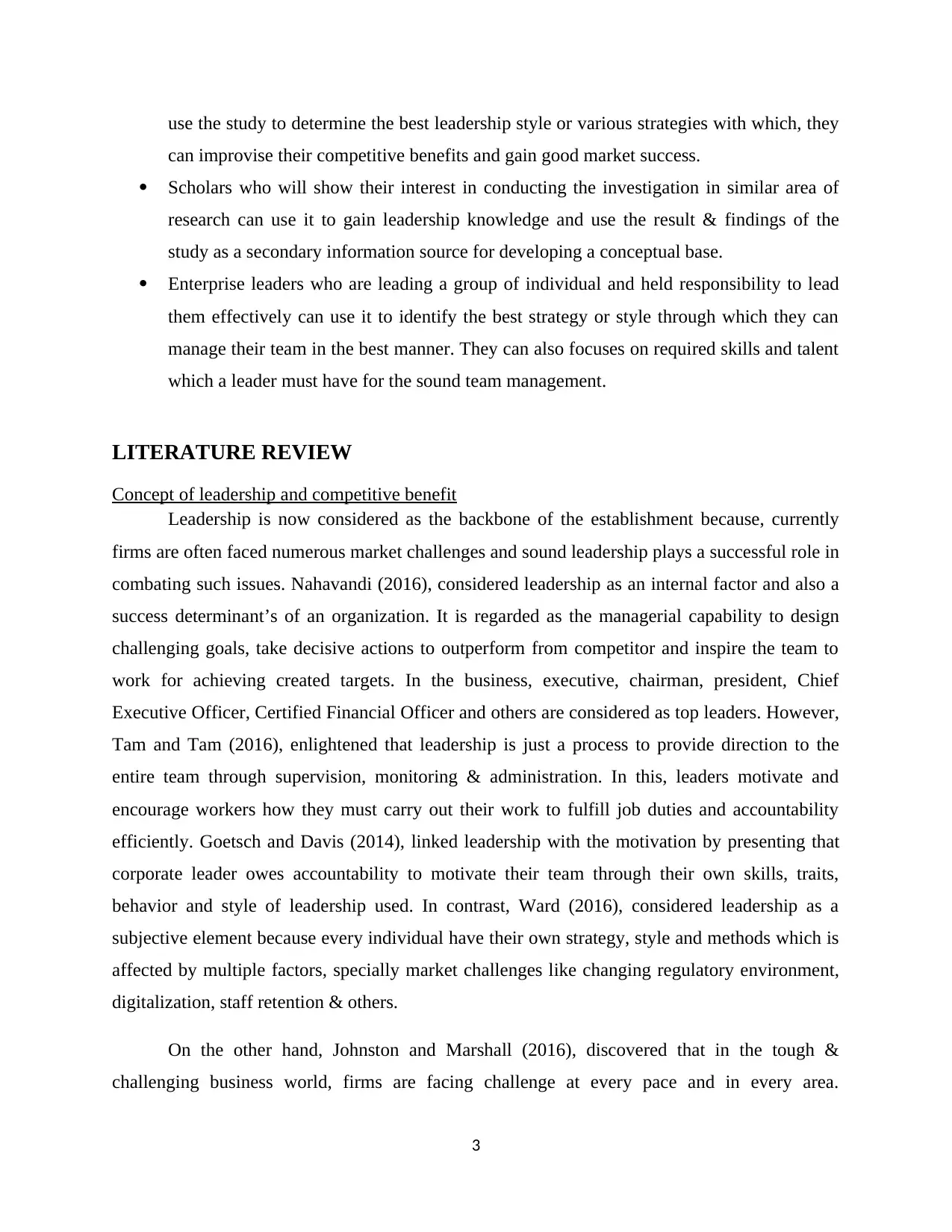
use the study to determine the best leadership style or various strategies with which, they
can improvise their competitive benefits and gain good market success.
Scholars who will show their interest in conducting the investigation in similar area of
research can use it to gain leadership knowledge and use the result & findings of the
study as a secondary information source for developing a conceptual base.
Enterprise leaders who are leading a group of individual and held responsibility to lead
them effectively can use it to identify the best strategy or style through which they can
manage their team in the best manner. They can also focuses on required skills and talent
which a leader must have for the sound team management.
LITERATURE REVIEW
Concept of leadership and competitive benefit
Leadership is now considered as the backbone of the establishment because, currently
firms are often faced numerous market challenges and sound leadership plays a successful role in
combating such issues. Nahavandi (2016), considered leadership as an internal factor and also a
success determinant’s of an organization. It is regarded as the managerial capability to design
challenging goals, take decisive actions to outperform from competitor and inspire the team to
work for achieving created targets. In the business, executive, chairman, president, Chief
Executive Officer, Certified Financial Officer and others are considered as top leaders. However,
Tam and Tam (2016), enlightened that leadership is just a process to provide direction to the
entire team through supervision, monitoring & administration. In this, leaders motivate and
encourage workers how they must carry out their work to fulfill job duties and accountability
efficiently. Goetsch and Davis (2014), linked leadership with the motivation by presenting that
corporate leader owes accountability to motivate their team through their own skills, traits,
behavior and style of leadership used. In contrast, Ward (2016), considered leadership as a
subjective element because every individual have their own strategy, style and methods which is
affected by multiple factors, specially market challenges like changing regulatory environment,
digitalization, staff retention & others.
On the other hand, Johnston and Marshall (2016), discovered that in the tough &
challenging business world, firms are facing challenge at every pace and in every area.
3
can improvise their competitive benefits and gain good market success.
Scholars who will show their interest in conducting the investigation in similar area of
research can use it to gain leadership knowledge and use the result & findings of the
study as a secondary information source for developing a conceptual base.
Enterprise leaders who are leading a group of individual and held responsibility to lead
them effectively can use it to identify the best strategy or style through which they can
manage their team in the best manner. They can also focuses on required skills and talent
which a leader must have for the sound team management.
LITERATURE REVIEW
Concept of leadership and competitive benefit
Leadership is now considered as the backbone of the establishment because, currently
firms are often faced numerous market challenges and sound leadership plays a successful role in
combating such issues. Nahavandi (2016), considered leadership as an internal factor and also a
success determinant’s of an organization. It is regarded as the managerial capability to design
challenging goals, take decisive actions to outperform from competitor and inspire the team to
work for achieving created targets. In the business, executive, chairman, president, Chief
Executive Officer, Certified Financial Officer and others are considered as top leaders. However,
Tam and Tam (2016), enlightened that leadership is just a process to provide direction to the
entire team through supervision, monitoring & administration. In this, leaders motivate and
encourage workers how they must carry out their work to fulfill job duties and accountability
efficiently. Goetsch and Davis (2014), linked leadership with the motivation by presenting that
corporate leader owes accountability to motivate their team through their own skills, traits,
behavior and style of leadership used. In contrast, Ward (2016), considered leadership as a
subjective element because every individual have their own strategy, style and methods which is
affected by multiple factors, specially market challenges like changing regulatory environment,
digitalization, staff retention & others.
On the other hand, Johnston and Marshall (2016), discovered that in the tough &
challenging business world, firms are facing challenge at every pace and in every area.
3
⊘ This is a preview!⊘
Do you want full access?
Subscribe today to unlock all pages.

Trusted by 1+ million students worldwide
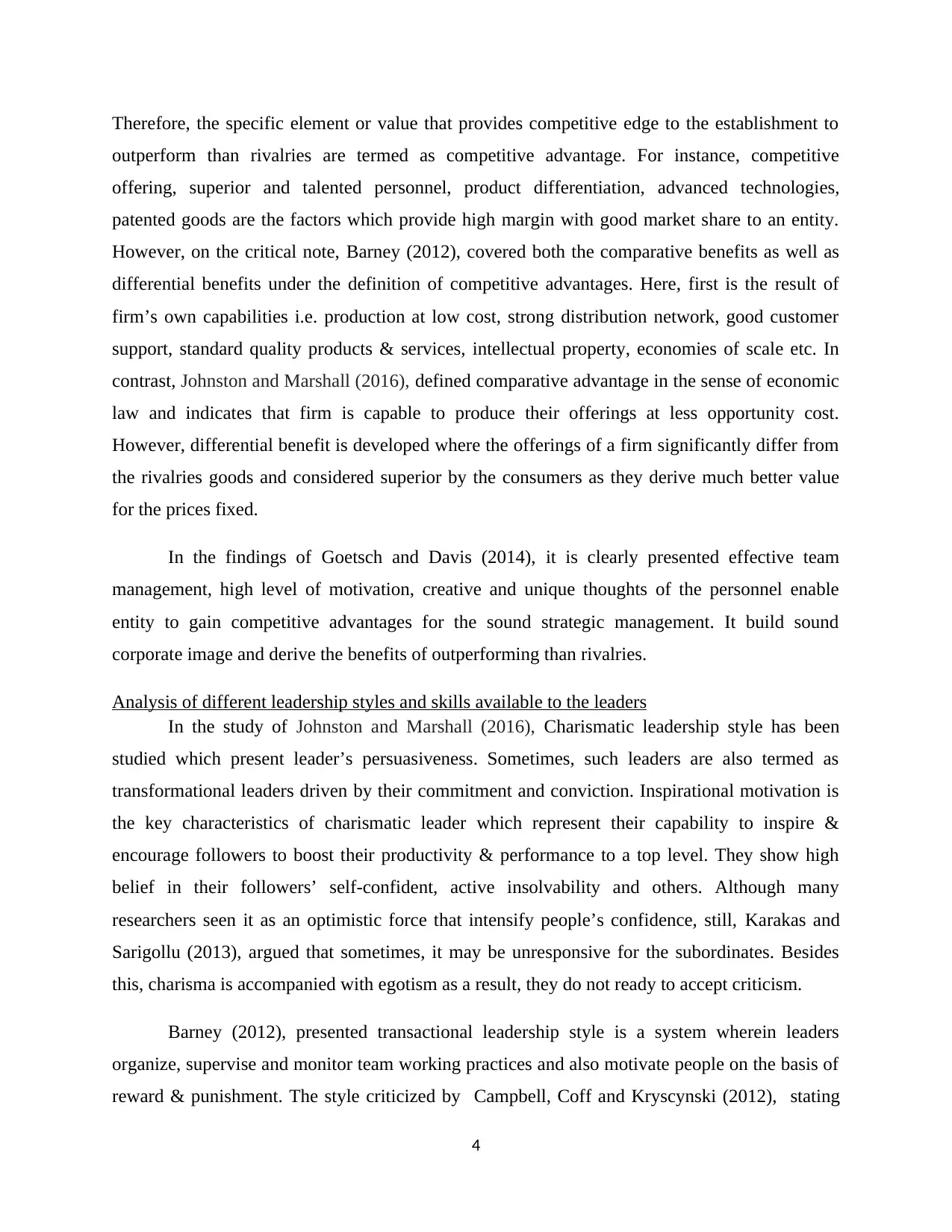
Therefore, the specific element or value that provides competitive edge to the establishment to
outperform than rivalries are termed as competitive advantage. For instance, competitive
offering, superior and talented personnel, product differentiation, advanced technologies,
patented goods are the factors which provide high margin with good market share to an entity.
However, on the critical note, Barney (2012), covered both the comparative benefits as well as
differential benefits under the definition of competitive advantages. Here, first is the result of
firm’s own capabilities i.e. production at low cost, strong distribution network, good customer
support, standard quality products & services, intellectual property, economies of scale etc. In
contrast, Johnston and Marshall (2016), defined comparative advantage in the sense of economic
law and indicates that firm is capable to produce their offerings at less opportunity cost.
However, differential benefit is developed where the offerings of a firm significantly differ from
the rivalries goods and considered superior by the consumers as they derive much better value
for the prices fixed.
In the findings of Goetsch and Davis (2014), it is clearly presented effective team
management, high level of motivation, creative and unique thoughts of the personnel enable
entity to gain competitive advantages for the sound strategic management. It build sound
corporate image and derive the benefits of outperforming than rivalries.
Analysis of different leadership styles and skills available to the leaders
In the study of Johnston and Marshall (2016), Charismatic leadership style has been
studied which present leader’s persuasiveness. Sometimes, such leaders are also termed as
transformational leaders driven by their commitment and conviction. Inspirational motivation is
the key characteristics of charismatic leader which represent their capability to inspire &
encourage followers to boost their productivity & performance to a top level. They show high
belief in their followers’ self-confident, active insolvability and others. Although many
researchers seen it as an optimistic force that intensify people’s confidence, still, Karakas and
Sarigollu (2013), argued that sometimes, it may be unresponsive for the subordinates. Besides
this, charisma is accompanied with egotism as a result, they do not ready to accept criticism.
Barney (2012), presented transactional leadership style is a system wherein leaders
organize, supervise and monitor team working practices and also motivate people on the basis of
reward & punishment. The style criticized by Campbell, Coff and Kryscynski (2012), stating
4
outperform than rivalries are termed as competitive advantage. For instance, competitive
offering, superior and talented personnel, product differentiation, advanced technologies,
patented goods are the factors which provide high margin with good market share to an entity.
However, on the critical note, Barney (2012), covered both the comparative benefits as well as
differential benefits under the definition of competitive advantages. Here, first is the result of
firm’s own capabilities i.e. production at low cost, strong distribution network, good customer
support, standard quality products & services, intellectual property, economies of scale etc. In
contrast, Johnston and Marshall (2016), defined comparative advantage in the sense of economic
law and indicates that firm is capable to produce their offerings at less opportunity cost.
However, differential benefit is developed where the offerings of a firm significantly differ from
the rivalries goods and considered superior by the consumers as they derive much better value
for the prices fixed.
In the findings of Goetsch and Davis (2014), it is clearly presented effective team
management, high level of motivation, creative and unique thoughts of the personnel enable
entity to gain competitive advantages for the sound strategic management. It build sound
corporate image and derive the benefits of outperforming than rivalries.
Analysis of different leadership styles and skills available to the leaders
In the study of Johnston and Marshall (2016), Charismatic leadership style has been
studied which present leader’s persuasiveness. Sometimes, such leaders are also termed as
transformational leaders driven by their commitment and conviction. Inspirational motivation is
the key characteristics of charismatic leader which represent their capability to inspire &
encourage followers to boost their productivity & performance to a top level. They show high
belief in their followers’ self-confident, active insolvability and others. Although many
researchers seen it as an optimistic force that intensify people’s confidence, still, Karakas and
Sarigollu (2013), argued that sometimes, it may be unresponsive for the subordinates. Besides
this, charisma is accompanied with egotism as a result, they do not ready to accept criticism.
Barney (2012), presented transactional leadership style is a system wherein leaders
organize, supervise and monitor team working practices and also motivate people on the basis of
reward & punishment. The style criticized by Campbell, Coff and Kryscynski (2012), stating
4
Paraphrase This Document
Need a fresh take? Get an instant paraphrase of this document with our AI Paraphraser
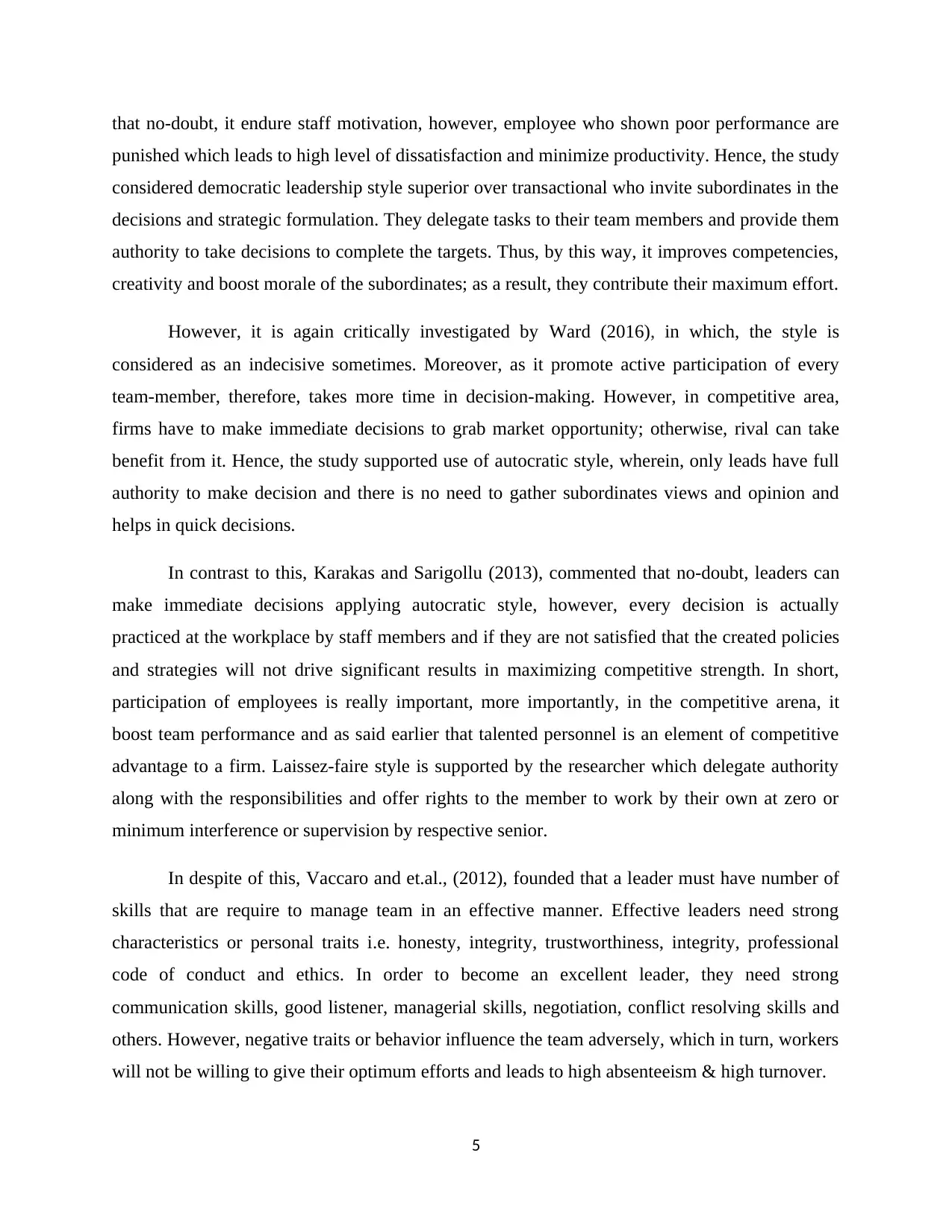
that no-doubt, it endure staff motivation, however, employee who shown poor performance are
punished which leads to high level of dissatisfaction and minimize productivity. Hence, the study
considered democratic leadership style superior over transactional who invite subordinates in the
decisions and strategic formulation. They delegate tasks to their team members and provide them
authority to take decisions to complete the targets. Thus, by this way, it improves competencies,
creativity and boost morale of the subordinates; as a result, they contribute their maximum effort.
However, it is again critically investigated by Ward (2016), in which, the style is
considered as an indecisive sometimes. Moreover, as it promote active participation of every
team-member, therefore, takes more time in decision-making. However, in competitive area,
firms have to make immediate decisions to grab market opportunity; otherwise, rival can take
benefit from it. Hence, the study supported use of autocratic style, wherein, only leads have full
authority to make decision and there is no need to gather subordinates views and opinion and
helps in quick decisions.
In contrast to this, Karakas and Sarigollu (2013), commented that no-doubt, leaders can
make immediate decisions applying autocratic style, however, every decision is actually
practiced at the workplace by staff members and if they are not satisfied that the created policies
and strategies will not drive significant results in maximizing competitive strength. In short,
participation of employees is really important, more importantly, in the competitive arena, it
boost team performance and as said earlier that talented personnel is an element of competitive
advantage to a firm. Laissez-faire style is supported by the researcher which delegate authority
along with the responsibilities and offer rights to the member to work by their own at zero or
minimum interference or supervision by respective senior.
In despite of this, Vaccaro and et.al., (2012), founded that a leader must have number of
skills that are require to manage team in an effective manner. Effective leaders need strong
characteristics or personal traits i.e. honesty, integrity, trustworthiness, integrity, professional
code of conduct and ethics. In order to become an excellent leader, they need strong
communication skills, good listener, managerial skills, negotiation, conflict resolving skills and
others. However, negative traits or behavior influence the team adversely, which in turn, workers
will not be willing to give their optimum efforts and leads to high absenteeism & high turnover.
5
punished which leads to high level of dissatisfaction and minimize productivity. Hence, the study
considered democratic leadership style superior over transactional who invite subordinates in the
decisions and strategic formulation. They delegate tasks to their team members and provide them
authority to take decisions to complete the targets. Thus, by this way, it improves competencies,
creativity and boost morale of the subordinates; as a result, they contribute their maximum effort.
However, it is again critically investigated by Ward (2016), in which, the style is
considered as an indecisive sometimes. Moreover, as it promote active participation of every
team-member, therefore, takes more time in decision-making. However, in competitive area,
firms have to make immediate decisions to grab market opportunity; otherwise, rival can take
benefit from it. Hence, the study supported use of autocratic style, wherein, only leads have full
authority to make decision and there is no need to gather subordinates views and opinion and
helps in quick decisions.
In contrast to this, Karakas and Sarigollu (2013), commented that no-doubt, leaders can
make immediate decisions applying autocratic style, however, every decision is actually
practiced at the workplace by staff members and if they are not satisfied that the created policies
and strategies will not drive significant results in maximizing competitive strength. In short,
participation of employees is really important, more importantly, in the competitive arena, it
boost team performance and as said earlier that talented personnel is an element of competitive
advantage to a firm. Laissez-faire style is supported by the researcher which delegate authority
along with the responsibilities and offer rights to the member to work by their own at zero or
minimum interference or supervision by respective senior.
In despite of this, Vaccaro and et.al., (2012), founded that a leader must have number of
skills that are require to manage team in an effective manner. Effective leaders need strong
characteristics or personal traits i.e. honesty, integrity, trustworthiness, integrity, professional
code of conduct and ethics. In order to become an excellent leader, they need strong
communication skills, good listener, managerial skills, negotiation, conflict resolving skills and
others. However, negative traits or behavior influence the team adversely, which in turn, workers
will not be willing to give their optimum efforts and leads to high absenteeism & high turnover.
5
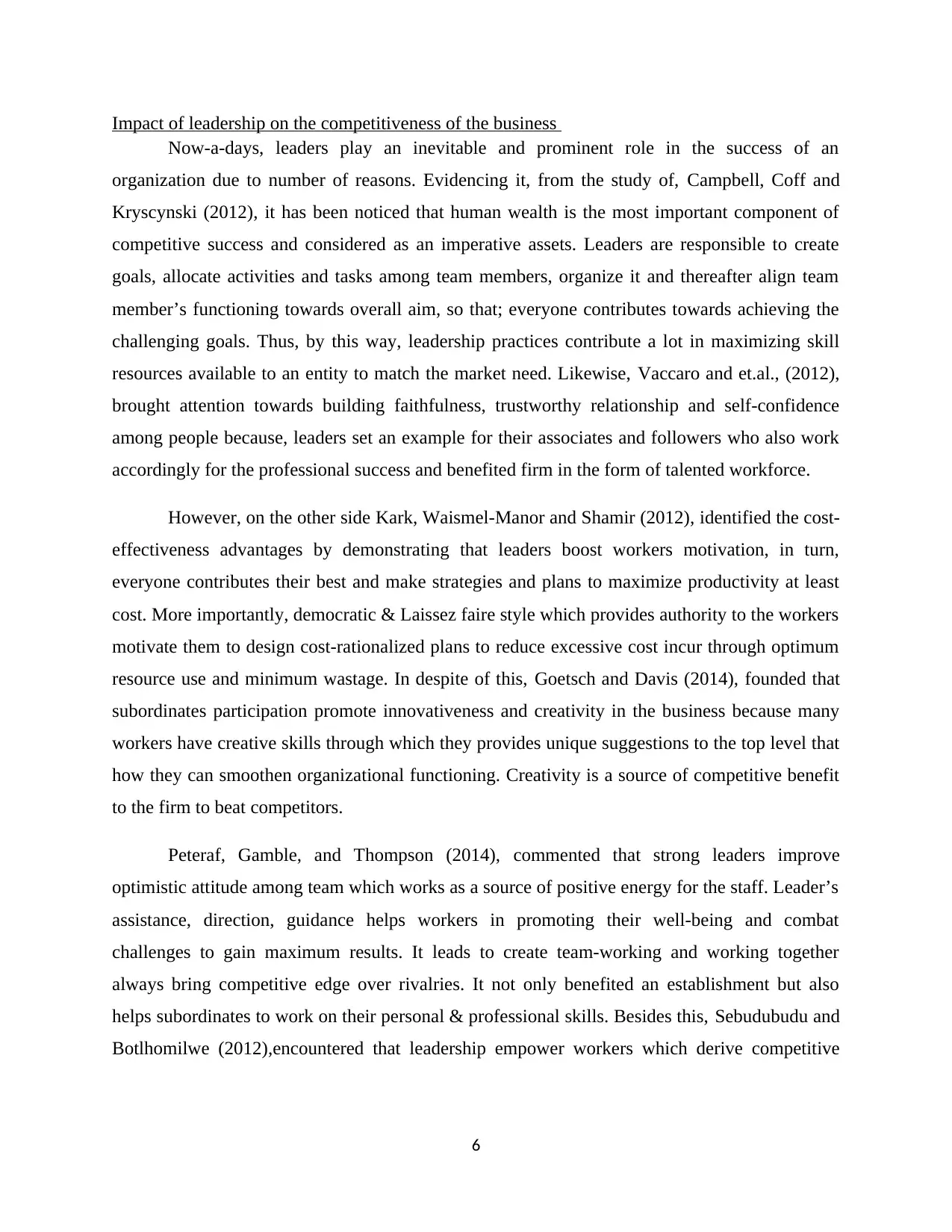
Impact of leadership on the competitiveness of the business
Now-a-days, leaders play an inevitable and prominent role in the success of an
organization due to number of reasons. Evidencing it, from the study of, Campbell, Coff and
Kryscynski (2012), it has been noticed that human wealth is the most important component of
competitive success and considered as an imperative assets. Leaders are responsible to create
goals, allocate activities and tasks among team members, organize it and thereafter align team
member’s functioning towards overall aim, so that; everyone contributes towards achieving the
challenging goals. Thus, by this way, leadership practices contribute a lot in maximizing skill
resources available to an entity to match the market need. Likewise, Vaccaro and et.al., (2012),
brought attention towards building faithfulness, trustworthy relationship and self-confidence
among people because, leaders set an example for their associates and followers who also work
accordingly for the professional success and benefited firm in the form of talented workforce.
However, on the other side Kark, Waismel-Manor and Shamir (2012), identified the cost-
effectiveness advantages by demonstrating that leaders boost workers motivation, in turn,
everyone contributes their best and make strategies and plans to maximize productivity at least
cost. More importantly, democratic & Laissez faire style which provides authority to the workers
motivate them to design cost-rationalized plans to reduce excessive cost incur through optimum
resource use and minimum wastage. In despite of this, Goetsch and Davis (2014), founded that
subordinates participation promote innovativeness and creativity in the business because many
workers have creative skills through which they provides unique suggestions to the top level that
how they can smoothen organizational functioning. Creativity is a source of competitive benefit
to the firm to beat competitors.
Peteraf, Gamble, and Thompson (2014), commented that strong leaders improve
optimistic attitude among team which works as a source of positive energy for the staff. Leader’s
assistance, direction, guidance helps workers in promoting their well-being and combat
challenges to gain maximum results. It leads to create team-working and working together
always bring competitive edge over rivalries. It not only benefited an establishment but also
helps subordinates to work on their personal & professional skills. Besides this, Sebudubudu and
Botlhomilwe (2012),encountered that leadership empower workers which derive competitive
6
Now-a-days, leaders play an inevitable and prominent role in the success of an
organization due to number of reasons. Evidencing it, from the study of, Campbell, Coff and
Kryscynski (2012), it has been noticed that human wealth is the most important component of
competitive success and considered as an imperative assets. Leaders are responsible to create
goals, allocate activities and tasks among team members, organize it and thereafter align team
member’s functioning towards overall aim, so that; everyone contributes towards achieving the
challenging goals. Thus, by this way, leadership practices contribute a lot in maximizing skill
resources available to an entity to match the market need. Likewise, Vaccaro and et.al., (2012),
brought attention towards building faithfulness, trustworthy relationship and self-confidence
among people because, leaders set an example for their associates and followers who also work
accordingly for the professional success and benefited firm in the form of talented workforce.
However, on the other side Kark, Waismel-Manor and Shamir (2012), identified the cost-
effectiveness advantages by demonstrating that leaders boost workers motivation, in turn,
everyone contributes their best and make strategies and plans to maximize productivity at least
cost. More importantly, democratic & Laissez faire style which provides authority to the workers
motivate them to design cost-rationalized plans to reduce excessive cost incur through optimum
resource use and minimum wastage. In despite of this, Goetsch and Davis (2014), founded that
subordinates participation promote innovativeness and creativity in the business because many
workers have creative skills through which they provides unique suggestions to the top level that
how they can smoothen organizational functioning. Creativity is a source of competitive benefit
to the firm to beat competitors.
Peteraf, Gamble, and Thompson (2014), commented that strong leaders improve
optimistic attitude among team which works as a source of positive energy for the staff. Leader’s
assistance, direction, guidance helps workers in promoting their well-being and combat
challenges to gain maximum results. It leads to create team-working and working together
always bring competitive edge over rivalries. It not only benefited an establishment but also
helps subordinates to work on their personal & professional skills. Besides this, Sebudubudu and
Botlhomilwe (2012),encountered that leadership empower workers which derive competitive
6
⊘ This is a preview!⊘
Do you want full access?
Subscribe today to unlock all pages.

Trusted by 1+ million students worldwide
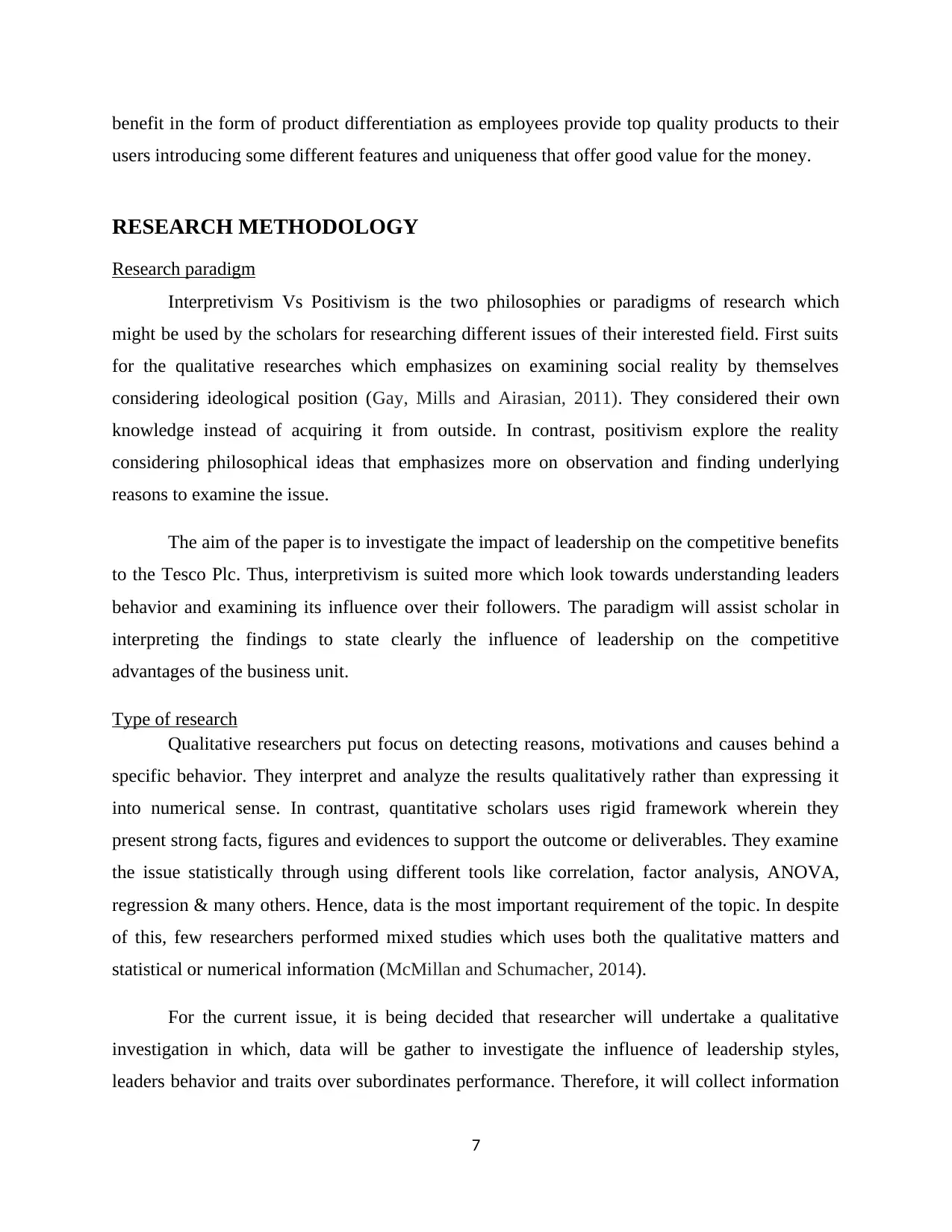
benefit in the form of product differentiation as employees provide top quality products to their
users introducing some different features and uniqueness that offer good value for the money.
RESEARCH METHODOLOGY
Research paradigm
Interpretivism Vs Positivism is the two philosophies or paradigms of research which
might be used by the scholars for researching different issues of their interested field. First suits
for the qualitative researches which emphasizes on examining social reality by themselves
considering ideological position (Gay, Mills and Airasian, 2011). They considered their own
knowledge instead of acquiring it from outside. In contrast, positivism explore the reality
considering philosophical ideas that emphasizes more on observation and finding underlying
reasons to examine the issue.
The aim of the paper is to investigate the impact of leadership on the competitive benefits
to the Tesco Plc. Thus, interpretivism is suited more which look towards understanding leaders
behavior and examining its influence over their followers. The paradigm will assist scholar in
interpreting the findings to state clearly the influence of leadership on the competitive
advantages of the business unit.
Type of research
Qualitative researchers put focus on detecting reasons, motivations and causes behind a
specific behavior. They interpret and analyze the results qualitatively rather than expressing it
into numerical sense. In contrast, quantitative scholars uses rigid framework wherein they
present strong facts, figures and evidences to support the outcome or deliverables. They examine
the issue statistically through using different tools like correlation, factor analysis, ANOVA,
regression & many others. Hence, data is the most important requirement of the topic. In despite
of this, few researchers performed mixed studies which uses both the qualitative matters and
statistical or numerical information (McMillan and Schumacher, 2014).
For the current issue, it is being decided that researcher will undertake a qualitative
investigation in which, data will be gather to investigate the influence of leadership styles,
leaders behavior and traits over subordinates performance. Therefore, it will collect information
7
users introducing some different features and uniqueness that offer good value for the money.
RESEARCH METHODOLOGY
Research paradigm
Interpretivism Vs Positivism is the two philosophies or paradigms of research which
might be used by the scholars for researching different issues of their interested field. First suits
for the qualitative researches which emphasizes on examining social reality by themselves
considering ideological position (Gay, Mills and Airasian, 2011). They considered their own
knowledge instead of acquiring it from outside. In contrast, positivism explore the reality
considering philosophical ideas that emphasizes more on observation and finding underlying
reasons to examine the issue.
The aim of the paper is to investigate the impact of leadership on the competitive benefits
to the Tesco Plc. Thus, interpretivism is suited more which look towards understanding leaders
behavior and examining its influence over their followers. The paradigm will assist scholar in
interpreting the findings to state clearly the influence of leadership on the competitive
advantages of the business unit.
Type of research
Qualitative researchers put focus on detecting reasons, motivations and causes behind a
specific behavior. They interpret and analyze the results qualitatively rather than expressing it
into numerical sense. In contrast, quantitative scholars uses rigid framework wherein they
present strong facts, figures and evidences to support the outcome or deliverables. They examine
the issue statistically through using different tools like correlation, factor analysis, ANOVA,
regression & many others. Hence, data is the most important requirement of the topic. In despite
of this, few researchers performed mixed studies which uses both the qualitative matters and
statistical or numerical information (McMillan and Schumacher, 2014).
For the current issue, it is being decided that researcher will undertake a qualitative
investigation in which, data will be gather to investigate the influence of leadership styles,
leaders behavior and traits over subordinates performance. Therefore, it will collect information
7
Paraphrase This Document
Need a fresh take? Get an instant paraphrase of this document with our AI Paraphraser
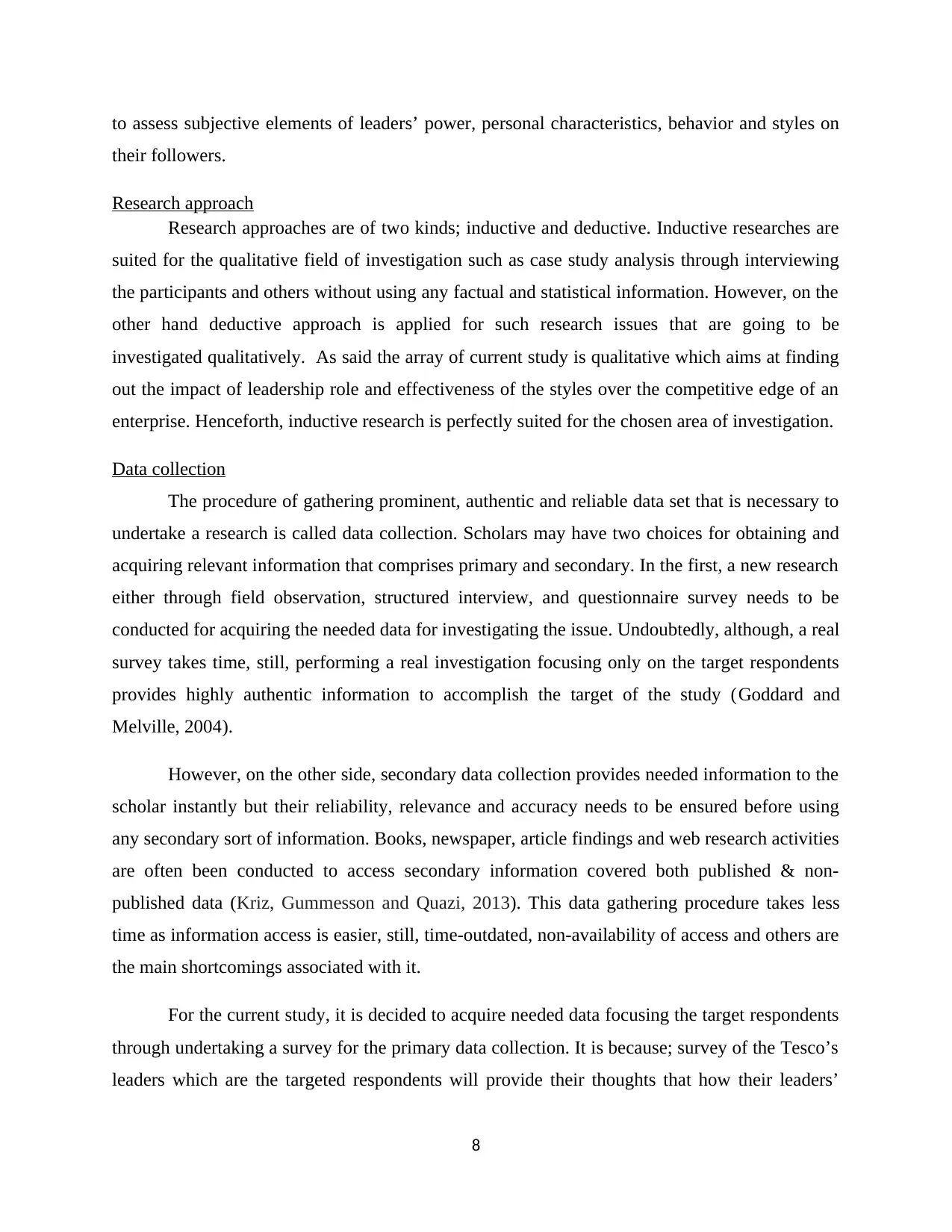
to assess subjective elements of leaders’ power, personal characteristics, behavior and styles on
their followers.
Research approach
Research approaches are of two kinds; inductive and deductive. Inductive researches are
suited for the qualitative field of investigation such as case study analysis through interviewing
the participants and others without using any factual and statistical information. However, on the
other hand deductive approach is applied for such research issues that are going to be
investigated qualitatively. As said the array of current study is qualitative which aims at finding
out the impact of leadership role and effectiveness of the styles over the competitive edge of an
enterprise. Henceforth, inductive research is perfectly suited for the chosen area of investigation.
Data collection
The procedure of gathering prominent, authentic and reliable data set that is necessary to
undertake a research is called data collection. Scholars may have two choices for obtaining and
acquiring relevant information that comprises primary and secondary. In the first, a new research
either through field observation, structured interview, and questionnaire survey needs to be
conducted for acquiring the needed data for investigating the issue. Undoubtedly, although, a real
survey takes time, still, performing a real investigation focusing only on the target respondents
provides highly authentic information to accomplish the target of the study (Goddard and
Melville, 2004).
However, on the other side, secondary data collection provides needed information to the
scholar instantly but their reliability, relevance and accuracy needs to be ensured before using
any secondary sort of information. Books, newspaper, article findings and web research activities
are often been conducted to access secondary information covered both published & non-
published data (Kriz, Gummesson and Quazi, 2013). This data gathering procedure takes less
time as information access is easier, still, time-outdated, non-availability of access and others are
the main shortcomings associated with it.
For the current study, it is decided to acquire needed data focusing the target respondents
through undertaking a survey for the primary data collection. It is because; survey of the Tesco’s
leaders which are the targeted respondents will provide their thoughts that how their leaders’
8
their followers.
Research approach
Research approaches are of two kinds; inductive and deductive. Inductive researches are
suited for the qualitative field of investigation such as case study analysis through interviewing
the participants and others without using any factual and statistical information. However, on the
other hand deductive approach is applied for such research issues that are going to be
investigated qualitatively. As said the array of current study is qualitative which aims at finding
out the impact of leadership role and effectiveness of the styles over the competitive edge of an
enterprise. Henceforth, inductive research is perfectly suited for the chosen area of investigation.
Data collection
The procedure of gathering prominent, authentic and reliable data set that is necessary to
undertake a research is called data collection. Scholars may have two choices for obtaining and
acquiring relevant information that comprises primary and secondary. In the first, a new research
either through field observation, structured interview, and questionnaire survey needs to be
conducted for acquiring the needed data for investigating the issue. Undoubtedly, although, a real
survey takes time, still, performing a real investigation focusing only on the target respondents
provides highly authentic information to accomplish the target of the study (Goddard and
Melville, 2004).
However, on the other side, secondary data collection provides needed information to the
scholar instantly but their reliability, relevance and accuracy needs to be ensured before using
any secondary sort of information. Books, newspaper, article findings and web research activities
are often been conducted to access secondary information covered both published & non-
published data (Kriz, Gummesson and Quazi, 2013). This data gathering procedure takes less
time as information access is easier, still, time-outdated, non-availability of access and others are
the main shortcomings associated with it.
For the current study, it is decided to acquire needed data focusing the target respondents
through undertaking a survey for the primary data collection. It is because; survey of the Tesco’s
leaders which are the targeted respondents will provide their thoughts that how their leaders’
8
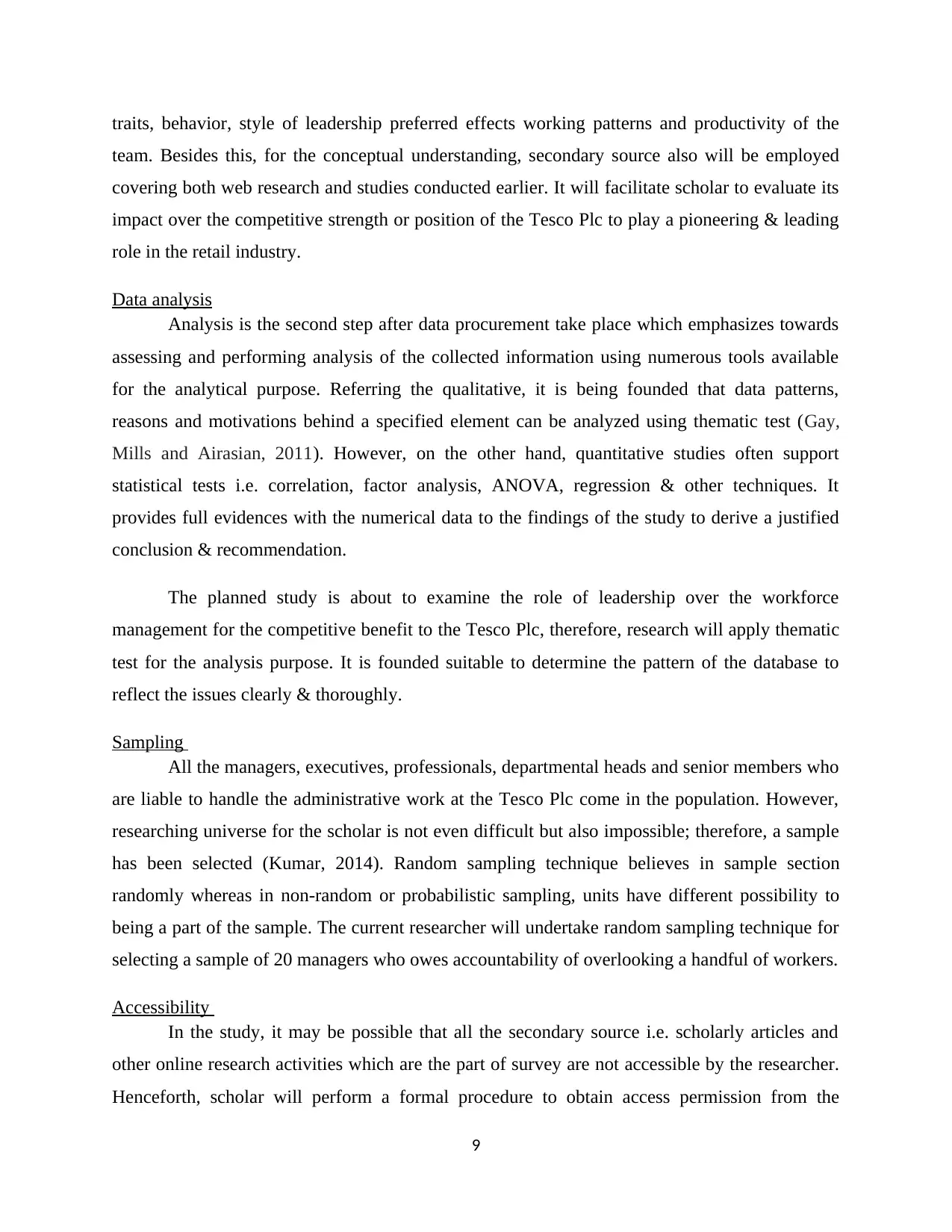
traits, behavior, style of leadership preferred effects working patterns and productivity of the
team. Besides this, for the conceptual understanding, secondary source also will be employed
covering both web research and studies conducted earlier. It will facilitate scholar to evaluate its
impact over the competitive strength or position of the Tesco Plc to play a pioneering & leading
role in the retail industry.
Data analysis
Analysis is the second step after data procurement take place which emphasizes towards
assessing and performing analysis of the collected information using numerous tools available
for the analytical purpose. Referring the qualitative, it is being founded that data patterns,
reasons and motivations behind a specified element can be analyzed using thematic test (Gay,
Mills and Airasian, 2011). However, on the other hand, quantitative studies often support
statistical tests i.e. correlation, factor analysis, ANOVA, regression & other techniques. It
provides full evidences with the numerical data to the findings of the study to derive a justified
conclusion & recommendation.
The planned study is about to examine the role of leadership over the workforce
management for the competitive benefit to the Tesco Plc, therefore, research will apply thematic
test for the analysis purpose. It is founded suitable to determine the pattern of the database to
reflect the issues clearly & thoroughly.
Sampling
All the managers, executives, professionals, departmental heads and senior members who
are liable to handle the administrative work at the Tesco Plc come in the population. However,
researching universe for the scholar is not even difficult but also impossible; therefore, a sample
has been selected (Kumar, 2014). Random sampling technique believes in sample section
randomly whereas in non-random or probabilistic sampling, units have different possibility to
being a part of the sample. The current researcher will undertake random sampling technique for
selecting a sample of 20 managers who owes accountability of overlooking a handful of workers.
Accessibility
In the study, it may be possible that all the secondary source i.e. scholarly articles and
other online research activities which are the part of survey are not accessible by the researcher.
Henceforth, scholar will perform a formal procedure to obtain access permission from the
9
team. Besides this, for the conceptual understanding, secondary source also will be employed
covering both web research and studies conducted earlier. It will facilitate scholar to evaluate its
impact over the competitive strength or position of the Tesco Plc to play a pioneering & leading
role in the retail industry.
Data analysis
Analysis is the second step after data procurement take place which emphasizes towards
assessing and performing analysis of the collected information using numerous tools available
for the analytical purpose. Referring the qualitative, it is being founded that data patterns,
reasons and motivations behind a specified element can be analyzed using thematic test (Gay,
Mills and Airasian, 2011). However, on the other hand, quantitative studies often support
statistical tests i.e. correlation, factor analysis, ANOVA, regression & other techniques. It
provides full evidences with the numerical data to the findings of the study to derive a justified
conclusion & recommendation.
The planned study is about to examine the role of leadership over the workforce
management for the competitive benefit to the Tesco Plc, therefore, research will apply thematic
test for the analysis purpose. It is founded suitable to determine the pattern of the database to
reflect the issues clearly & thoroughly.
Sampling
All the managers, executives, professionals, departmental heads and senior members who
are liable to handle the administrative work at the Tesco Plc come in the population. However,
researching universe for the scholar is not even difficult but also impossible; therefore, a sample
has been selected (Kumar, 2014). Random sampling technique believes in sample section
randomly whereas in non-random or probabilistic sampling, units have different possibility to
being a part of the sample. The current researcher will undertake random sampling technique for
selecting a sample of 20 managers who owes accountability of overlooking a handful of workers.
Accessibility
In the study, it may be possible that all the secondary source i.e. scholarly articles and
other online research activities which are the part of survey are not accessible by the researcher.
Henceforth, scholar will perform a formal procedure to obtain access permission from the
9
⊘ This is a preview!⊘
Do you want full access?
Subscribe today to unlock all pages.

Trusted by 1+ million students worldwide
1 out of 17
Related Documents
Your All-in-One AI-Powered Toolkit for Academic Success.
+13062052269
info@desklib.com
Available 24*7 on WhatsApp / Email
![[object Object]](/_next/static/media/star-bottom.7253800d.svg)
Unlock your academic potential
Copyright © 2020–2025 A2Z Services. All Rights Reserved. Developed and managed by ZUCOL.





